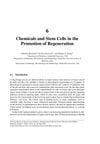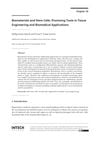Search
forLearn
2 / 2 resultslearn Neem Oil
natural substance from Neem tree with medicinal and pesticidal properties
Research
5 / 1000+ resultsresearch Adult Stem Cell Released Molecules in Combination with Microneedling Restore Hair Growth
Combining stem cell molecules with microneedling improves hair growth.

research Chemicals and Stem Cells in the Promotion of Regeneration
Chemicals and stem cells combined have advanced regenerative medicine with few safety concerns, focusing on improving techniques and treatment effectiveness.

research Conditioned Media Derived from Mesenchymal Stem Cell Cultures: The Next Generation for Regenerative Medicine
Conditioned media from mesenchymal stem cell cultures could be a more effective alternative for regenerative therapies, but more research is needed.

research Biomaterials and Stem Cells: Promising Tools in Tissue Engineering and Biomedical Applications
Biomaterials combined with stem cells show promise for improving tissue repair and medical treatments.
research Current Advanced Therapies Based on Human Mesenchymal Stem Cells for Skin Diseases
Human mesenchymal stem cells show promise for treating skin diseases, but more research is needed to improve treatments.
Community Join
5 / 413 resultscommunity Eirion Therapeutics Announces Potential Breakthrough Treatment for Hair Loss Based on First-in-Man Clinical Trial Results
ET-02, a new hair loss treatment, shows promising results with a 6-fold increase in hair count, potentially outperforming minoxidil by activating stem cells in hair follicles. Further trials are ongoing to confirm its efficacy and safety, with potential market release in the future.
community My Theory Of Androgenic Alopecia
Hair loss is linked to cellular physiology and the IGF-1 to TGF-B1 ratio, not just androgen sensitivity. The theory lacks evidence, while finasteride and minoxidil are effective treatments.
community A concise, easy-to-understand post on Androgenic Alopecia theory and its practical applications
The mechanism of Androgenic Alopecia and practical applications of treatments like Minoxidil, Finasteride, RU58841, dermarolling, scalp massages, anti-fungals, progesterone, estrogen, PPAR-γ activators, reducing oxidative stress, and scalp exercises. It explains why DHT is important in AA and how other factors might be involved such as hypoxia, increased DKK-1 expression, morphological changes to the scalp, skull growth during childhood/puberty, and blood flow.
community The Real Cause Of Androgenetic Alopecia
Androgenetic alopecia is caused by DHT affecting hair growth. Finasteride and minoxidil are used to manage hair loss by blocking DHT and promoting hair growth.
community How ET-02 Works. Also no proof that it's better than Minoxidil. At least for now.
ET-02, a PAI-1 inhibitor, is not proven to be more effective than Minoxidil for hair loss. Other treatments like finasteride, dutasteride, PP405, and AMP-303 are also discussed, focusing on cellular senescence and oxidative stress.